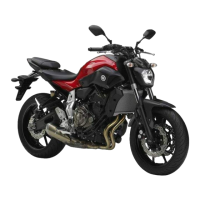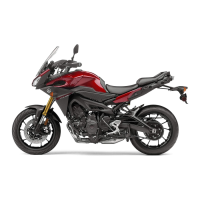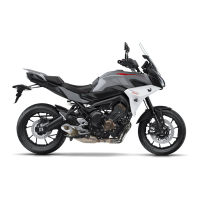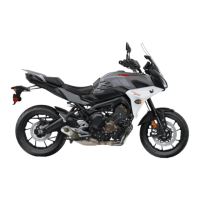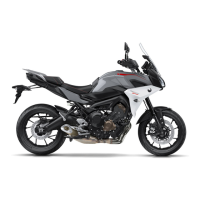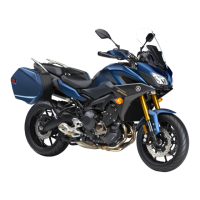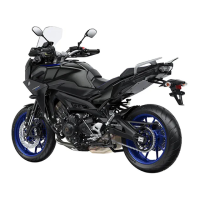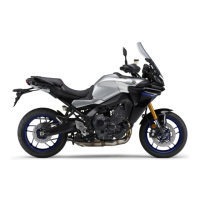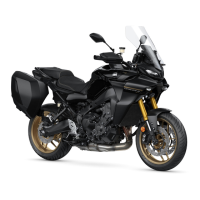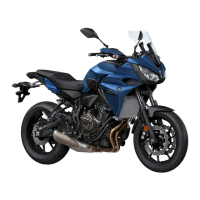
Do you have a question about the Yamaha MT07 TRACER and is the answer not in the manual?
| Bore x Stroke | 80.0 mm x 68.6 mm |
|---|---|
| Compression Ratio | 11.5 : 1 |
| Maximum Power | 55.0 kW (74.8 PS) @ 9, 000 rpm |
| Fuel System | Fuel Injection |
| Final Drive | Chain |
| Front Brakes | Hydraulic dual disc, Ø 282 mm |
| Rear Brakes | Hydraulic single disc, Ø 245 mm |
| Front Tyre | 120/70 ZR17M/C (58W) |
| Rear Tyre | 180/55 ZR17M/C (73W) |
| Maximum Torque | 68.0 Nm (6.9 kgf-m) @ 6, 500 rpm |
| Transmission | 6-speed |
| Front Suspension | Telescopic fork |
| Rear Suspension | Swingarm (link suspension) |
| Fuel Tank Capacity | 17.0 litres |
| Engine Type | Liquid-cooled, 4-stroke, DOHC, 4-valve, parallel twin |
Guidance for owners on safe motorcycle operation and responsibilities.
Essential checks and precautions for ensuring safe operation of the vehicle.
Recommends specific safety gear for rider protection during operation.
Covers carbon monoxide risks, loading guidelines, and general safety.
Advice on genuine and aftermarket parts, including tires and modifications.
Instructions and precautions for safely transporting the vehicle.
Visual identification of key components on the left and right sides of the motorcycle.
Location and basic identification of all handlebar controls and dashboard instruments.
Explanation of the anti-theft system, keys, and indicator light.
Operation of the ignition, lighting, and steering lock mechanisms.
Explains warning lights, indicator lights, and system status signals.
Guides on using the speedometer, tachometer, clock, fuel, and other display functions.
Operation of all switches and levers on the handlebars for control.
How to use the clutch lever and shift pedal for gear changes.
Location and operation of the front brake lever and rear brake pedal.
Functionality and operation of the ABS for enhanced braking control.
Information on the fuel tank cap, fuel level, and related hoses.
Procedures for seat removal, storage use, and windshield adjustment.
Adjusting shock absorber, checking sidestand, and ignition cut-off system.
Information on the vehicle's auxiliary power outlet for accessories.
Verifies fuel, engine oil, and coolant levels and checks for leaks.
Inspects front/rear brake operation, pads, fluid levels, and hydraulic systems.
Checks drive chain, pedals, levers, sidestand, and fasteners for proper function.
Inspects wheels and tires for damage, tread depth, and air pressure.
Verifies operation of instruments, lights, signals, and the sidestand switch.
Step-by-step guide for safely starting the motorcycle's engine.
Explains the process of changing gears for optimal performance and control.
Advice on improving fuel efficiency through riding style and maintenance.
Guidelines for the initial period to ensure engine longevity and performance.
Safe methods for parking the motorcycle, considering heat and stability.
Outlines periodic checks and services for emission control and general systems.
Procedures for checking, changing engine oil, and replacing the oil filter cartridge.
Steps for checking and changing the engine coolant.
Procedures for checking brake pads, fluid levels, and changing brake fluid.
Instructions for checking slack, cleaning, and lubricating the drive chain.
Information on battery care, charging, storage, and replacing fuses.
Steps to diagnose and resolve common starting or engine performance issues.
Guidelines for washing, cleaning plastic parts, and specific cautions.
Applying protective sprays, polishing metal parts, and waxing.
Instructions for short-term and long-term storage to protect the vehicle.
Technical data including length, width, height, wheelbase, and curb weight.
Specifications for engine, transmission, fuel capacity, and recommended fuel.
Details on frame, suspension, wheel types, and brake system components.
Information on electrical system, tire sizes, air pressure, and bulb types.
Location and importance of VIN, engine serial number, and model label for registration.
Explains data collected by the ECU and Yamaha's privacy policy.
